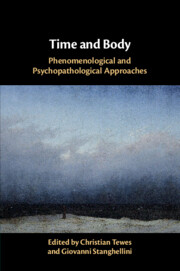Book contents
- Time and Body
- Endorsements for Time and Body
- Time and Body
- Copyright page
- Dedication
- Additional material
- Contents
- Figures
- Contributors
- 1 Introduction – Time and Body
- 2 Time, the Body, and the Other in Phenomenology and Psychopathology
- Part I Body and Time: General Aspects
- Part II Grief and Anxiety
- Part III Borderline Personality and Eating Disorders
- 9 Emotion Regulation in a Disordered World
- 9.1 Commentary on “Emotion Regulation in a Disordered World: Understanding Borderline Personality Disorder”
- 10 Nobody? Disturbed Self-Experience in Borderline Personality Disorder and Four Kinds of Instabilities
- 10.1 Commentary on “Nobody? Disturbed Self-Experience in Borderline Personality Disorder and Four Kinds of Instabilities”
- 11 Levels of Embodiment
- 11.1 Commentary on “Levels of Embodiment: A Husserlian Analysis of Gender and the Development of Eating Disorders”
- 12 Phenomenology of Corporeality (and Spatiality) in Anorexia Nervosa with a Reference to the Problem of Its Temporality
- 12.1 Commentary on “Phenomenology of Corporeality (and Spatiality) in Anorexia Nervosa with a Reference to the Problem of Its Temporality”
- Part IV Depression, Schizophrenia, and Dementia
- Index
- References
12.1 - Commentary on “Phenomenology of Corporeality (and Spatiality) in Anorexia Nervosa with a Reference to the Problem of Its Temporality”
Anorexia Nervosa: Linking the Phenomenology to Cultural and Neuropsychological Aspects of the Disease
from Part III - Borderline Personality and Eating Disorders
Published online by Cambridge University Press: 30 October 2020
- Time and Body
- Endorsements for Time and Body
- Time and Body
- Copyright page
- Dedication
- Additional material
- Contents
- Figures
- Contributors
- 1 Introduction – Time and Body
- 2 Time, the Body, and the Other in Phenomenology and Psychopathology
- Part I Body and Time: General Aspects
- Part II Grief and Anxiety
- Part III Borderline Personality and Eating Disorders
- 9 Emotion Regulation in a Disordered World
- 9.1 Commentary on “Emotion Regulation in a Disordered World: Understanding Borderline Personality Disorder”
- 10 Nobody? Disturbed Self-Experience in Borderline Personality Disorder and Four Kinds of Instabilities
- 10.1 Commentary on “Nobody? Disturbed Self-Experience in Borderline Personality Disorder and Four Kinds of Instabilities”
- 11 Levels of Embodiment
- 11.1 Commentary on “Levels of Embodiment: A Husserlian Analysis of Gender and the Development of Eating Disorders”
- 12 Phenomenology of Corporeality (and Spatiality) in Anorexia Nervosa with a Reference to the Problem of Its Temporality
- 12.1 Commentary on “Phenomenology of Corporeality (and Spatiality) in Anorexia Nervosa with a Reference to the Problem of Its Temporality”
- Part IV Depression, Schizophrenia, and Dementia
- Index
- References
Summary
Otto Doerr-Zegers and Héctor Pelegrina-Cetran (2021) elaborate a phenomenology of corporeality and temporality in anorexia nervosa. With respect to the corporeality, they describe a fragmentation of the polarity between subject-body as a corporealized being in the world and the object-body as a mere thing. In patients with anorexia nervosa, the self develops disgust and rejection of the volumetric-physical body, which is accompanied by intellectualization and rationalization.
- Type
- Chapter
- Information
- Time and BodyPhenomenological and Psychopathological Approaches, pp. 282 - 286Publisher: Cambridge University PressPrint publication year: 2020

